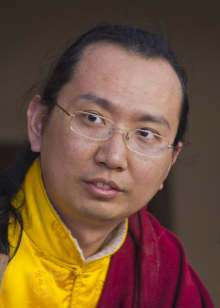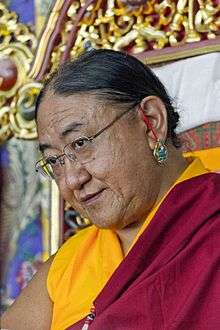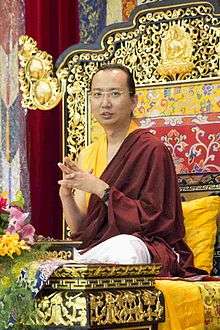Sakya Trizin

Ratna Vajra Rinpoche

longest reigning Sakya Trizin
Sakya Trizin (Tibetan: ས་སྐྱ་ཁྲི་འཛིན།, Wylie: sa skya khri 'dzin "Sakya Throne-Holder") is the traditional title of the head of the Sakya school of Tibetan Buddhism.[1]
The Sakya school was founded in 1073CE,[2] when Khön Könchog Gyalpo (Tibetan: འཁོན་དཀོན་མཆོག་རྒྱལ་པོ།, Wylie: 'khon dkon mchog rgyal po ; 1034–1102), a member of Tibet’s noble Khön family, established a monastery in the region of Sakya, Tibet, which became the headquarters of the Sakya order.[3] Since that time, its leadership has descended within the Khön family.
The 41st Sakya Trizin, whose reign spanned more than fifty years, was the longest reigning Sakya Trizin[4]. The current Sakya Trizin is the 42nd Sakya Trizin Ratna Vajra Rinpoche, officially known as Kyabgon Gongma Trizin Rinpoche. [5]
Origin of Khön
Lharig, the divine generation
- According to legend Ciring descended from the Rupadhatu (Realm of Clear Light) to earth.
- Ciring
- Yuse
- Yuring
- Masang Cije
- Togsa Pawo Tag
- Tagpo Ochen
- Yapang Kye
Khön family, the royal generation Because previous generations subjugated the rakshasas (demons), the family became the Family of Conquerors (Wylie: khon gyi dung , shortened to Khön)[6] and therefore a royal family.
- Khön Bar Kye
- Khön Jekundag, minister of Trisong Detsen, student of Padmasambhava
- Khön Lu'i Wangpo Srungwa
- Khön Dorje Rinchen
- Khön Sherab Yontan
- Khön Yontan Jungne
- Khön Tsugtor Sherab
- Khön Gekyab
- Khön Getong
- Khön Balpo
- Khön Shakya Lodro
- Sherab Tsultrim
Sakya Trizin Lineage
Sakya lineage, generations as Buddhist teachers.[7]
- Khon Konchog Gyalpo founded the monastery in Sakya in 1073, and therefore the lineage was renamed Sakya.[8]
| Name | Biographical data | Tenure | Tibetan name | |
|---|---|---|---|---|
| 1. | Khon Konchog Gyalpo | 1034–1102 | 1073–1102 | Tibetan: འཁོན་དཀོན་མཆོག་རྒྱལ་པོ།, Wylie: khon dkon mchog rgyal po |
| 2. | Rinchen Drag | 1040–1111 | 1103–1110 | Tibetan: བ་རི་ལོ་ཙ་བ་རིན་ཆེན་གྲགས།, Wylie: ba ri lo tsa ba rin chen grags |
| 3. | Sachen Kunga Nyingpo | 1092–1158 | 1111–1158 | Tibetan: ས་ཆེན་ཀུན་དགའ་སྙིང་པོ།, Wylie: sa chen kun dga’ snying po |
| 4. | Sonam Tsemo | 1142–1182 | 1159–1171 | Tibetan: བསོད་ནམས་རྩེ་མོ།, Wylie: bsod nams rtse mo |
| 5. | Dragpa Gyaltsen | 1147–1216 | 1172–1215 | Tibetan: རྗེ་བཙུན་རིན་པོ་ཆེ།, Wylie: grags pa rgyal mtshan |
| 6. | Sakya Pandita | 1182–1251 | 1216–1243 | Tibetan: ས་སྐྱ་པཎྜི་ཏ་ཀུན་དགའ་རྒྱལ་མཚན།, Wylie: sa skya pandi ta kun dga’ rgyal mtshan |
| 6a. | regent of Sakya Pandita | 1243–1264 | Tibetan: ས་སྐྱ་པཎྜི་ཏ་ཀུན་དགའ་རྒྱལ་མཚན།, Wylie: sa skya pandi ta kun dga’ rgyal mtshan | |
| 7. | Drogön Chögyal Phagpa | 1235–1280 | 1265–1266 1276–1280 | Tibetan: ཆོས་རྒྱལ་འཕགས་པ་བློ་གྲོས་རྒྱལ་མཚན།, Wylie: chos rgyal 'phags pa blo gros rgyal mtshan |
| 8. | Rinchen Gyaltsen | 1238–1279 | 1267–1275 | Tibetan: རིན་ཆེན་རྒྱལ་མཚན།, Wylie: rin chen rgyal mtshan |
| 7a. | Drogön Chögyal Phagpa 2nd reign | 1276–1280 | Tibetan: ཆོས་རྒྱལ་འཕགས་པ་བློ་གྲོས་རྒྱལ་མཚན།, Wylie: chos rgyal 'phags pa blo gros rgyal mtshan | |
| 9. | Dharmapala Rakshita[9] | 1268–1287 | 1281–1287 | Tibetan: དྷརྨ་པཱ་ལ་རཀཥི་ཏ།, Wylie: d+harma pA la rakaShi ta |
| 10. | Jamyang Rinchen Gyaltsen | 1258–1306 | 1288–1297 | Tibetan: ཤར་པ་འཇམ་དབྱངས་རིན་ཆེན་རྒྱལ་མཚན།, Wylie: shar pa 'jam dbyangs rin chen rgyal mtshan |
| 11. | Sangpo Pal | 1262–1324 | 1298–1324 | Tibetan: བཟང་པོ་དཔལ།, Wylie: bzang po dpal |
| 12. | Namkha Legpa Gyaltsen | 1305–1343 | ca. 1324–1342 | Tibetan: ནམ་མཁའ་ལེགས་པའི་རྒྱལ་མཚན།, Wylie: nam mkha' legs pa'i rgyal mtshan |
| 13. | Jamyang Donyö Gyaltsen | 1310–1344 | ca. 1342-1344 | Tibetan: འཇམ་དབྱངས་དོན་ཡོད་རྒྱལ་མཚན།, Wylie: 'jam dbyangs don yod rgyal mtshan |
| 14. | Lama Dampa Sönam Gyaltsen | 1312–1375 | 1344–1347 | Tibetan: བླ་མ་དམ་པ་བསོད་ནམས་རྒྱལ་མཚན།, Wylie: bla ma dam pa bsod nams rgyal mtshan |
| 15. | Tawen Lodrö Gyaltsen | 1332–1364 | 1347–1364 | Tibetan: ཏ་དབེན་བློ་གྲོས་རྒྱལ་མཚན།, Wylie: ta dben blo gros rgyal mtshan |
| 16. | Tawen Kunga Rinchen | 1339–1399 | ca. 1364-1399 | Tibetan: ཏ་དབེན་ཀུན་དགའ་རིན་ཆེན།, Wylie: ta dben kun dga' rin chen |
| 17. | Lopön Chenpo Gushri Lodrö Gyaltsen | 1366–1420 | 1399–1420 | Wylie: slob dpon chen po gu shri blo gros rgyal mtshan |
| 18. | Jamyang Namkha Gyaltsen | 1398–1472 | 1421–1441 | Wylie: 'jam dbyangs nam mkha' rgyal mtshan |
| 19. | Kunga Wangchuk | 1418–1462 | 1442–1462 | Wylie: kun dga' dbang phyug |
| 20. | Gyagar Sherab Gyaltsen | 1436–1494 | 1463–1472 | Wylie: rgya gar ba shes rab rgyal mtshan |
| 21. | Dagchen Lodrö Gyaltsen | 1444–1495 | 1473–1495 | Wylie: bdag chen blo gros rgyal mtshan |
| 22. | Kunga Sönam | 1485–1533 | 1496–1533 | Wylie: sa skya lo tsa ba kun dga' bsod nams |
| 23. | Ngagchang Kunga Rinchen | 1517–1584 | 1534–1584 | Wylie: sngags 'chang kun 'dga rin chen |
| 24. | Jamyang Sönam Sangpo | 1519–1621 | 1584–1589 | Wylie: 'jam dbyangs bsod nams bzang po |
| 25. | Dragpa Lodrö | 1563–1617 | 1589–1617 | Wylie: grags pa blo gros |
| 26. | Ngawang Kunga Wangyal | 1592–1620 | 1618–1620 | Wylie: ngag dbang kun dga' dbang rgyal |
| 27. | Ngawang Kunga Sönam | 1597–1659 | 1620–1659 | Wylie: ngag dbang kun dga' bsod nams |
| 28. | Ngawang Sönam Wangchuk | 1638–1685 | 1659–1685 | Wylie: ngag dbang bsod nams dbang phyug |
| 29. | Ngawang Kunga Tashi | 1656–1711 | 1685–1711 | Wylie: ngag dbang kun dga' bkra shis |
| 30. | Sönam Rinchen | 1705–1741 | 1711–1741 | Wylie: bsod nams rin chen |
| 31. | Kunga Lodrö | 1729–1783 | 1741–1783 | Wylie: kun dga' blo gros |
| 32. | Wangdu Nyingpo | 1763–1809 | 1783–1806 | Wylie: dbang sdud snying po |
| 33. | Pema Dudul Wangchuk | 1792–1853 | 1806–1843 | Wylie: pad ma bdud 'dul dbang phyug |
| 34. | Dorje Rinchen | 1819–1867 | 1843–1845 | Wylie: rdo rje rin chen |
| 35. | Tashi Rinchen | 1824–1865 | 1846–1865 | Wylie: bkra shis rin chen |
| 36. | Kunga Sönam | 1842–1882 | 1866–1882 | Wylie: kun dga' bsod nams |
| 37. | Kunga Nyingpo | 1850–1899 | 1883–1899 | Wylie: kun dga' snying po |
| 38. | Dzamling Chegu Wangdu | 1855–1919 | 1901–1915 | Wylie: 'dzam gling che rgu dbang 'dud |
| 39. | Dragshul Trinle Rinchen | 1871–1936 | 1915–1936 | Tibetan: དྲག་ཤུལ་འཕྲིན་ལས་རིན་ཆེན།, Wylie: drag shul 'phrin las rin chen, ZYPY: Chagxü Chinlä Rinqên |
| 40. | Ngawang Thutob Wangdrag | 1900–1950 | 1937–1950 | Tibetan: ངག་དབང་མཐུ་སྟོབས་དབང་དྲག, Wylie: ngag dbang mthu stobs dbang drag |
| 41. | Ngawang Kunga Tegchen Palbar *see Sakya Trizin Ngawang Kunga | * 1945 | 1951–2017 | Tibetan: ངག་དབང་ཀུན་དགའ་ཐེག་ཆེན་དཔལ་འབར་འཕྲིན་ལས་བསམ་འཕེལ་དབང་གྱི་རྒྱལ་པོ།, Wylie: ngag dbang kun dga' theg chen dpal 'bar trin lé sam pel wang gyi gyel po |
| 42. | Ratna Vajra Rinpoche | * 1974 | 2017– | Tibetan: ངག་དབང་ཀུན་དགའ་བློ་གྲོས་དབང་ཕྱུག་རིན་ཆེན་འཇིགས་མེད་འཕྲིན་ལས།, Wylie: nNgag dBang Kun dGa' Blo Gros Rin Chen 'Jigs Med 'Phrin Las |

New Succession System
On 11 December 2014, a new throne holder succession system was announced during the 23rd Great Sakya Mönlam prayer festival on a resolution passed by the Dolma Phodrang and Phuntsok Phodrang, where members of both Phodrang will serve the role of Sakya Trizin in one three year term, according to their seniority and qualification.[10][11]
Ratna Vajra Rinpoche was enthroned on 9th March 2017 as the 42nd Sakya Trizin, the first to be enthroned under the new system.[5]
Footnotes
- ↑ Holy Biographies of the Great Founders of the Glorious Sakya Order, translated by Venerable Lama Kalsang Gyaltsen, Ani Kunga Chodron and Victoria Huckenpahler. Published by Sakya Phuntsok Ling Publications, Silver Spring MD. June 2000.
- ↑ http://tibet.net/about-tibet/glimpses-on-history-of-tibet/
- ↑ The History of the Sakya Tradition, by Chogay Trichen. Manchester Free Press, U.K. 1983.
- ↑ shttp://www.hhthesakyatrizin.org/currentnews_jubilee.html
- 1 2 http://www.rigpawiki.org/index.php?title=Kyabgon_Gongma_Trizin_Rinpoche
- ↑ "{title}". Archived from the original on 2017-05-24. Retrieved 2017-06-07.
- ↑ Drogmi Buddhist Institute, Throneholders of Sakya
- ↑ http://drogmi.org/the-sakya-tradition/the-sakya-lineage
- ↑ A བ༹ཕྱོང་རྒྱས་པ།/琼结巴 or from ས་ཧོར།/萨护罗国/萨霍尔国. Son of 达玛惹扎, grandson of 夏扎布达,( ISBN 7800575462) or son of ཕྱག་ན་རྡོ་རྗེ།/恰那多吉?
- ↑ http://www.hhthesakyatrizin.org/pdfs/HHSakyaTrizin_2014Announcement.pdf%5Bpermanent+dead+link%5D
- ↑ http://sakyatrizinenthronement.org/